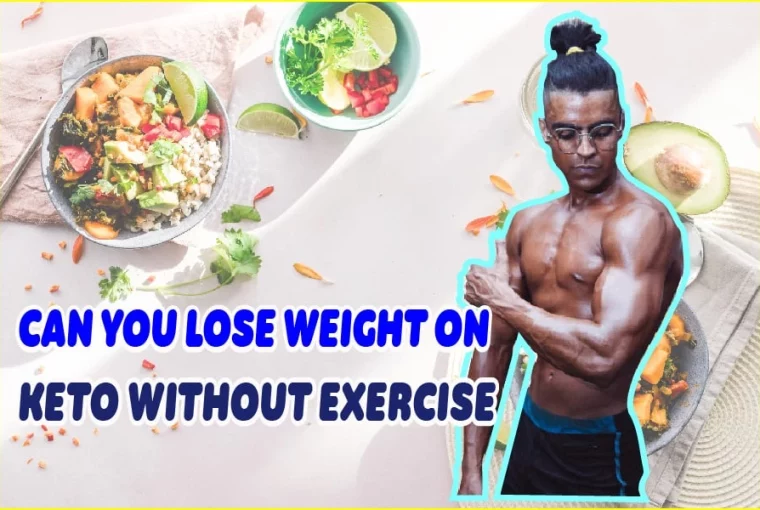Many people are making an effort to live healthy lives. Dietary trends are prevalent, and people are more conscious of eating.
The prevalence of lifestyle-related illnesses is relatively high, especially in developed countries. The worst affected demographic is people over the age of 25. In America, 33% of all adults are overweight, and the statistic is only getting worse.
People pursuing weight loss are encouraged to use dieting alongside exercise. Doing so ensures that you have a caloric deficit and consequently lose weight.
What better way to archive the debt than by incorporating a smoothie into your diet? Click here to find out more.
Can you lose weight on a Keto Diet Without Exercise?
Yes, you can. While dieting and exercise go together, it is entirely possible to induce a caloric deficit exclusively on keto. All you need to do is strictly adhere to the guidelines of the Standard Ketogenic Diet.
How To Lose Weight On Keto Without Exercise
Inducing a caloric deficit is the key to weight loss on keto. If you do it right, you do not need exercise. Combining keto with exercise, however, will make you lose weight faster.
The best way to do it is to follow a Standard Keto Diet (SKD) strictly.
A standard Keto Diet entails:
70% fat: the proportion of fat in your food should be about 70%. You should limit yourself to unsaturated fat from organic food. You can derive them from avocados, peanuts, olive oil, pumpkin seeds, etc.
20% Protein: Be very strict with the proportion of protein on your diet, or you risk knocking your body out of ketosis.
While on a Standard Keto Diet, you must strictly avoid red meat as a source of protein, as it is less healthy.
Take fish and poultry meat, but do so in moderation to stay in ketosis.
10% carbohydrates: The entire premise of having a keto diet is to reduce the consumption of carbs. While you can’t completely cut them out, they must never exceed 10% of your overall diet, particularly for SKD.
By strictly following the Standard Ketogenic Diet, you eliminate the need for exercise. Some variations of the keto diet allow you to keep exercising. They are the Standard Ketogenic Diet and the High Protein Ketogenic Diet.
How Does Keto Work?
A keto diet often called a ketogenic diet, is a low-carb, high-fat diet. Its primary purpose is to aid weight reduction, offering several additional health benefits. The ketogenic diet works by putting you into a state of ketosis.
Ketosis is a metabolic state in which the liver creates ketones and stores them in the muscles. In the absence of carbs, ketones supply the body with basic energy. The liver metabolizes proteins into energy that the body may utilize.
You can supplement your keto diet with a healthy smoothie. Click here to find out more.
In the lack of carbs, ketosis is initiated. It is a natural stimulation that assures your survival in the face of famine. Dietary ketosis is the process of achieving ketosis with a low carbohydrate diet.
What Foods Are Keto Incompatible?
When on a keto diet, it is important to eat within your requirements strictly. It will ensure that your body stays in ketosis. Staying in ketosis helps to reduce weight and keeps you lean.
There are foods that you should avoid, as they interfere with ketosis. They are:
Alcoholic beverages: Alcohol contains a lot of sugar and starch. Never use alcohol when on a keto diet, as it will undoubtedly interfere with ketosis.
Juice: Fruit juice contains sugar known as fructose. Fructose is digested into basic monosaccharides, which increases sugar in your body, consequently disrupting ketosis.
Beans: Though beans are a healthy protein source, they contain a high proportion of carbohydrates. It would help if you avoided them.
Saturated fats: These are unhealthy types of fat. They are found in processed foods such as bacon, sausages, biscuits, cheese, coconut oil, etc.
Grains: Though grains are a healthy source of unsaturated fats, their carb content is too high for a ketogenic diet. Avoid rice, oats, wheat, barley, etc.
Other Variations Of Ketogenic Diet
There are several variations of the ketogenic diet. These diets are ideal for different people and people with varying energy requirements. They include:
1. Protein-based Keto Diet
The 6:3:1 fat, protein, and carbohydrate ratio are acceptable for a high-protein keto diet. You should consume 30 grams of protein and 60 grams of fat for every 10 grams of carbs consumed.
Protein shakes are ideal for ketogenic diets. The carb content should always remain low.
2. Targeted Ketogenic Diet
The Standard Ketogenic Diet is a version of the Targeted Keto Diet. While on the TKD, all of the ratios stay the same. The distinction is that you can consume carbs 45 minutes before exercise.
The Targeted Ketogenic Diet is designed for persons who engage in highly intense, physically demanding work. It raises glucose levels just enough to get you through the workout without kicking you out of ketosis for an extended amount of time.
3. Cyclical Keto
The Cyclical Ketogenic Diet mixes the conventional ketogenic diet with days when carbs are allowed. Athletes are advised to use it.
The CKT is designed to initiate glycogenesis, which converts carbs into basic monosaccharides. The body utilizes the energy created during the process of respiration.
Other Advantages Of A Ketogenic Diet
A ketogenic diet has several benefits beyond weight loss. There are several other health advantages of strictly observing a keto diet. They include:
1. Treating urinary ailments
Ketogenic diets have been found in research to minimize the risk of kidney disease. Long-term carbohydrate restriction resulted in higher amounts of hydroxybutyric acid. It prevents the body from reacting aggressively to glucose. Early signs of the research are promising.
2. Cancer prevention
Ketosis aids in the deprivation of glucose by malignant cells. The cellular metabolic activities of malignant cells are slowed, and their fast development is inhibited by limiting the insulin supply.
The efficacy of ketogenic diets as a technique of decreasing the development of malignant cells is promising.
3. Epilepsy management in children
Ketogenic diets reduce epileptic seizures in children under the age of 18. According to studies, children who strictly use a keto diet have had only half as many attacks as those who don’t. One in ten patients had no attacks after switching to a keto diet.
When paired with epilepsy treatment, a ketogenic diet is adequate.
4. Improved heart health
A ketogenic diet can aid in the control of risk factors that can lead to heart disease. The type of fat you consume is crucial. You should consume healthy fats like Omega 3 and unsaturated fats for a ketogenic diet.
Unsaturated fats can help eliminate saturated fats. It will minimize fatty deposits in your liver and heart, potentially preventing atherosclerosis and insulin resistance.
Potential Side Effects Of Switching To Keto
Switching to a keto diet is helpful as a way of combating obesity. If you stick to the diet, you will notice notable improvements in your health.
There are some side effects of switching to keto. Some people might not experience them, but most people do. These side effects include:
Nausea
Nausea is a typical adverse effect of following a ketogenic diet. A high-fat diet can cause nausea, which can be a bit too much for most people. The body should eventually acclimate to a high-fat diet.
If nausea persists, ask your doctor to prescribe anti-nausea medication.
Hypoglycemia
As you reduce your sugar intake, you are likely to exhibit some mild symptoms of hypoglycemia.
If you already suffer from the condition, it is ill-advised to use a keto diet. Consult a medical professional before starting a keto diet.
Constipation
Fiber is often absent from a ketogenic diet. Carbohydrates include the majority of naturally occurring fiber.
As a result, you may feel constipation in the first few weeks of starting a keto diet. If this happens, drink lots of water to reduce constipation. Anti-constipation medication also helps.
Fatigue during the day
Even if you are doing non-energy heavy chores, cutting back on carbs will make you tired. Carbohydrates are digested into glucose, which is oxidized to supply energy to the muscles during respiration.
Protein metabolization takes a long time, but it will ultimately give you enough energy to sustain you through the day.
Conclusion
For the best results on weight loss, you are encouraged to change your diet and exercise simultaneously. You should note that exercising alone will not help induce a caloric deficit, as you have to watch the number of carbs you consume daily.
One of the most effective ways of losing weight is by embracing a keto diet. The high fat, low-carb, and low-cal diet works wonders in helping you to reduce weight. Aside from weight loss, it also helps minimize epileptic shocks in children.




